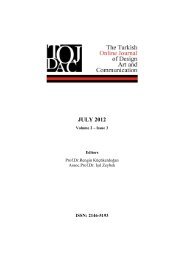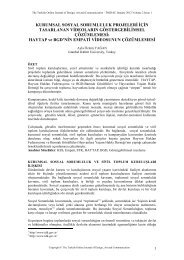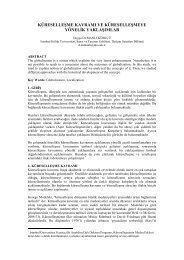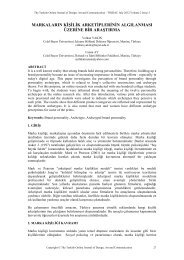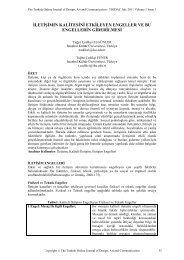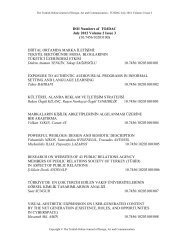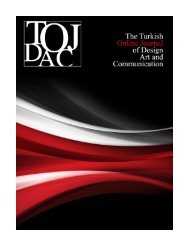aprıl 2012 - tojdac.org
aprıl 2012 - tojdac.org
aprıl 2012 - tojdac.org
Create successful ePaper yourself
Turn your PDF publications into a flip-book with our unique Google optimized e-Paper software.
The Turkish Online Journal of Design, Art and Communication - TOJDAC April <strong>2012</strong> Volume 2 Issue 2<br />
our experience of media is a hybrid of texts, images, and sounds, rather than pure states of any<br />
one mode.<br />
During that time, mostly by the end of 1960s, the so called Fine Arts faced a great paradigm.<br />
Post-modern scholars, such as Rosalind Krauss in “Sculpture in the Expanded Field” (1983),<br />
Lucy Lippard’s “The Dematerialization of The Art Object” (1968), and Arthur Danto (1998),<br />
who describes this period as “Pluralist”, wrote a vast amount of articles and books. The<br />
concepts were applied to the all the new art practices outside the traditional canvas and<br />
sculpture, mostly performance, installation, earth and land art, video, computer art, and many<br />
others with its own hybridization of mediums.<br />
1.1 Antenna And Roots<br />
What does happen when digital equipment invades cultures where technological language is<br />
not yet well understood What does happen to a rich visual culture society and the<br />
impossibility to follow what is called digital progress How does society maintain its own<br />
visual culture and take advantage of progress, at the same time Based in these questions our<br />
approach to Visual Culture in this paper aims to propose a reflexion about a research called<br />
Antenna and Roots.<br />
As a full professor from the Fine Art School of the Federal University of Bahia, teaching at<br />
both graduate and undergraduate levels, it was very clear to see the student’s desire to<br />
experiment with technology, in the beginning of 2000s. However, considering the sociofinancial<br />
aspect of a public university, as well as the financial condition of our country, we<br />
had to start to think how important was the digital equipments in art, and what could we do to<br />
work with them. Because of the so called low tech equipments became more popular and<br />
available, they could contribute to encourage students to create images with any kind of<br />
machine, softwares, with the understanding that a good art work does not rely only in the<br />
equipment, but how an artist approaches it in order to materialize his/her ideas, without<br />
illustrating any kind of theory.<br />
Following the title-name of our project, the word antenna, that means the apparatus that<br />
transmit information, in a mostly fast way, in short time and space, is a metaphor word<br />
applied to progress. While root means a person or family as the source of offspring or<br />
descendants, a person's original or ancestral home, environment, culture, affinity for a place,<br />
habits, etc., that make a locale one's true home.<br />
The "high art" world is both a source and destination for the whole of visual culture, but<br />
popular forms get rechanneled through art world validated art genres and venues, when we<br />
think about the hybridization of visual media. The Post-1980s expansion of art media and<br />
image technologies, mostly centered in digital images, or photography, can dialogue with<br />
other traditional visual practices and materials.<br />
The contemporary visual languages, intrinsically, connects questions that involve man facing<br />
a world in constant development, globalized, multifaceted, technological, where the signs<br />
that represent things changes its meaning in function of spaces that they occupy temporarily<br />
or of a more lasting form.<br />
The 21st century, unlike previous periods, allows a look to the past, democratically, and<br />
divides the same space without hierarchies. The gap of specific limits between material and<br />
techniques – before defined as "noble" – were part of the concept that characterized the<br />
transition of the post-modern transition. This transition became a great paradigm in the visual<br />
arts, when concepts of transformations, appropriation, hybridization, dematerialization,<br />
deconstruction, displacement and relocation became part of the new visual vocabulary,<br />
permitting to the artist occupy several positions and explore <strong>org</strong>anizations of work that were<br />
not conditioned to an alone language.<br />
Copyright © The Turkish Online Journal of Design, Art and Communication 109



